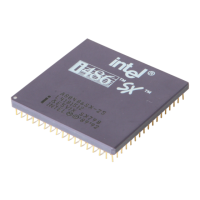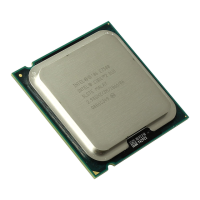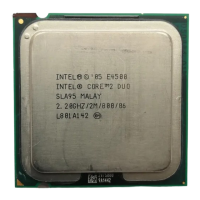EMBEDDED Intel486™ PROCESSOR HARDWARE REFERENCE MANUAL
10-14
The amount of reflection voltage can be easily calculated. Figure 10-10 shows a system exhibit-
ing reflections.
The magnitude of a reflection is usually represented in terms of a reflection coefficient. This is
illustrated in the following equations:
t = v
r
/v
i
= Reflected voltage/Incident voltage
t
L
= t
Load
= (Z
L
– Z
0
)/ (Z
L
+ Z
0
)
t
S
= t
Source
= (Z
S
– Z
0
)/ (Z
S
+ Z
0
)
Reflection voltage v
r
is given by v
i
, the voltage incident at the point of the reflection, and the re-
flection coefficient.
The model transmission line can now be completed. In Figure 10-10, the voltage seen at point A
is given by the following equation:
V
A
= V
S
* Z
0
/(Z
0
+ Z
S
)
This voltage V
A
enters the transmission line at “A” and appears at “B” delayed by t
pd
.
V
B
= V
A
(t – x/v) H(t – x/v)
where x = distance along the transmission line from point “A” and H(t) is the unit step function.
The waveform encounters the load Z
L
, and this may cause reflection. The reflected wave enters
the transmission line at “B” and appears at point “A” after time delay (t
pd
):
V
r1
= t
L
·V
B
This phenomenon continues infinitely, but it is negligible after 3 or 4 reflections. Hence:
V
r2
= t
S
·V
r1
Each reflected waveform is treated as a separate source that is independent of the reflection co-
efficient at that point and the incident waveform. Thus the waveform from any point and on the
transmission line and at any given time is as follows:
V(x,t) = Z
0
/(Z
0
+ Z
S
) { [V
S
(t-x/v)H(t-x/v)]
t
L
[V
S
(t-(2L-x)/v)] [H(t-(2L-x)/v)]
t
L
t
S
[V
S
(t-(2L + x)/v)] [H(t-(2L + x)/v)]
t
1
2
t
S
[V
S
(t-(4L-x)/v)] [H(t-(4L-x)/v)]
t
1
2
t
S
2
[V
S
(t - (4L+x)/v)] [H(t(4L+x)/v)]
+.............}
Each reflection is added to the total voltage through the unit step function H(t). The above equa-
tion can be rewritten as follows:

